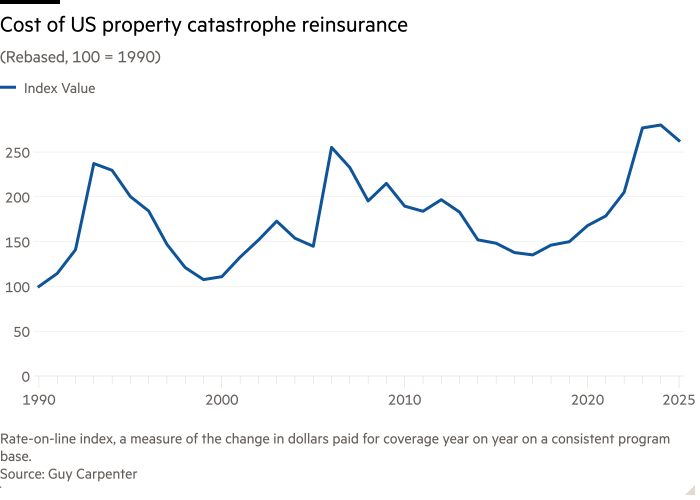Unlock the Editor’s Digest for free
Roula Khalaf, Editor of the FT, selects her favourite stories in this weekly newsletter.
Gaps in California’s insurance system could lead to serious failures in coverage for the Los Angeles firestorms, while leaving a key segment of the industry — reinsurance companies meant to spread out the most concentrated risk — virtually unscathed.
Reinsurers, which provide insurance to frontline insurance companies, could ultimately absorb less than 3 per cent of insured losses from the blazes, Citi analysts said.
California’s governor Gavin Newsom has said the fires, which have damaged or destroyed 12,000 buildings, could be the costliest disaster in US history, with early estimates suggesting insured losses could exceed $20bn.
The mild hit to reinsurers highlights how they have quietly pared exposure to natural catastrophe risks in recent years, raising prices and increasing the level at which coverage kicks in. That pullback accelerated the retreat of major insurance carriers in California, industry experts said, leaving many homeowners without cover or turning to the state-backed insurer of last resort.
“Reinsurers backed away from taking on a lot of that [catastrophe] risk. So, the insurers naturally said, we want to step away,” said Andrew Engler, co-founder of Kettle, a wildfire-focused insurance technology business in California.
State Farm and Allstate, two of California’s largest providers of homeowners’ insurance, cited the cost of reinsurance, along with factors such as high construction costs, when they announced last year they would stop writing new policies in the state.
Insurers have long complained California law makes it challenging to raise premiums to match the losses they face. In December, insurance commissioner Ricardo Lara issued new rules aimed at making it easier to raise rates, including by allowing reinsurance costs to be passed on to customers.
But that regulation had not taken effect by January, and its future effect could be muted by a broader shift in the industry. As global insured losses have climbed in recent years, reinsurers’ share of those losses has fallen.
Last year, US reinsurance rates hit their highest level since at least 1990, according to a cost index published by Guy Carpenter, a Marsh McLennan-owned reinsurance broker.

Over the past 25 years, reinsurers assumed about 46 per cent of modelled catastrophe risk, but that exposure has been cut to 33 per cent since 2023, according to the reinsurance arm of broker Howden.
Reinsurers remain exposed to so-called peak perils such as earthquakes and hurricanes. But fires, which have become more costly and intense because of urban growth and climate change, are less likely to hit the higher threshold that triggers reinsurance payments.
Munich Re, the world’s biggest reinsurer which provides coverage to major US primary carriers, said in a 2020 investor presentation it had “reduced appetite” in reinsurance for so-called secondary perils such as wildfire.
The reinsurers’ retreat followed years of painful losses. Munich Re booked €500mn of wildfire losses in 2017, the year when the Tubbs fire swept through Northern California, and €430mn of losses in 2018, following two other major fires in the state.
Munich Re told the Financial Times: “We remain committed to providing natural catastrophe capacity across all markets, as long as we can achieve prices that adequately reflect the risk.”
In 2022, rising interest rates and inflation squeezed reinsurance capital supply, triggering a reset for the industry, when reinsurers negotiated tougher terms and higher prices with clients.
“The reset in 2023 was on the back of heavy loss activity in prior years,” one executive at a major reinsurer said.
Reinsurers raised prices in 2023 and 2024. Citi predicted January’s losses could drive a “significant” increase in reinsurance prices when many policies are renewed in early summer, ahead of the US hurricane season.
“If I’m a reinsurance company and I’ve got a very good relationship with State Farm nationally, then I might begrudgingly take on some Californian wildfire risk, as part of a diversified portfolio,” said James Shuck, Citi’s head of European insurance research. “But the fundamental problem is, it’s an uninsurable risk. There comes a point at which you have to raise prices by so much that it becomes uneconomic.”
Climate Capital

Where climate change meets business, markets and politics. Explore the FT’s coverage here.
Are you curious about the FT’s environmental sustainability commitments? Find out more about our science-based targets here










